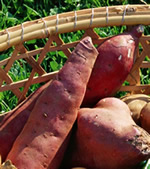Sweet potato
Sweet potato (Ipomoea batatas (L.) Lam.), originated from American tropics, belongs to the family of Convolvulaceae. It is also known in Chinese as “Fanshu”, “Digga”, “Shanyu”, “Tienshu”, “Honshu”, “Honshayu”, “Huangshu” and “Baishu”.
 Taiwan's geographic location falls between the tropic and the sub-tropic zone, and its environmental condition is very suitable for the growth of sweet potato. Sweet potato is characterized for its good environmental adaptability, high tolerance to various stresses and easy rejuvenation of leaves and roots. Hence, sweet potato is grown almost anywhere in Taiwan. Its major production areas are Yunlin, Taichung, Miaoli and Changhwa counties, with Pington, Taipei, Taitung and Hwalian counties next.
Taiwan's geographic location falls between the tropic and the sub-tropic zone, and its environmental condition is very suitable for the growth of sweet potato. Sweet potato is characterized for its good environmental adaptability, high tolerance to various stresses and easy rejuvenation of leaves and roots. Hence, sweet potato is grown almost anywhere in Taiwan. Its major production areas are Yunlin, Taichung, Miaoli and Changhwa counties, with Pington, Taipei, Taitung and Hwalian counties next.
The majority of Taiwan's high-quality sweet potatoes are consumed freshly as part of cooked dishes, the rest are used for processing. Recently, it was discovered that the nutrient content of sweet potato leaf is higher than other common leafy vegetables. Hence, stir-fried sweet potato leaves had become a favorite dish at the dinner table. Currently, the major cultivars for cooking sweet potato are ‘Tai Nong 57, Tai Nong 66, Tai Nong 68 and Taoyuan #1’; as for leafy sweet potato, there are ‘Tai Nong 71’ and ‘Taoyuan #2’ available.
In addition to its abundant starch and somewhat limited proteins and fats, those of which are similar to that of cereal crops, sweet potato also contains vitamin C as well as the pro-vitamin A - β-carotene. The nutritional value of sweet potato is well recognized by doctors and nutritionists. Therefore, sweet potato is a valuable food for both the children and the seniors; and is regarded to be an agricultural product with high potential for future development.
In the future, the sweet potato industry of Taiwan will focus on improving its quality. The production system shall be moving toward refinement and specialization. The goals for future development will be to reduce total yield but with improved quality, emphasizing freshness, uniqueness, and diversification in processing products. It is hoped that sweet potato will become a food crop with both competitiveness and local characteristics. To further expand the usefulness of sweet potato, research into the healthy and life-beneficial aspect of sweet potato will be explored.
